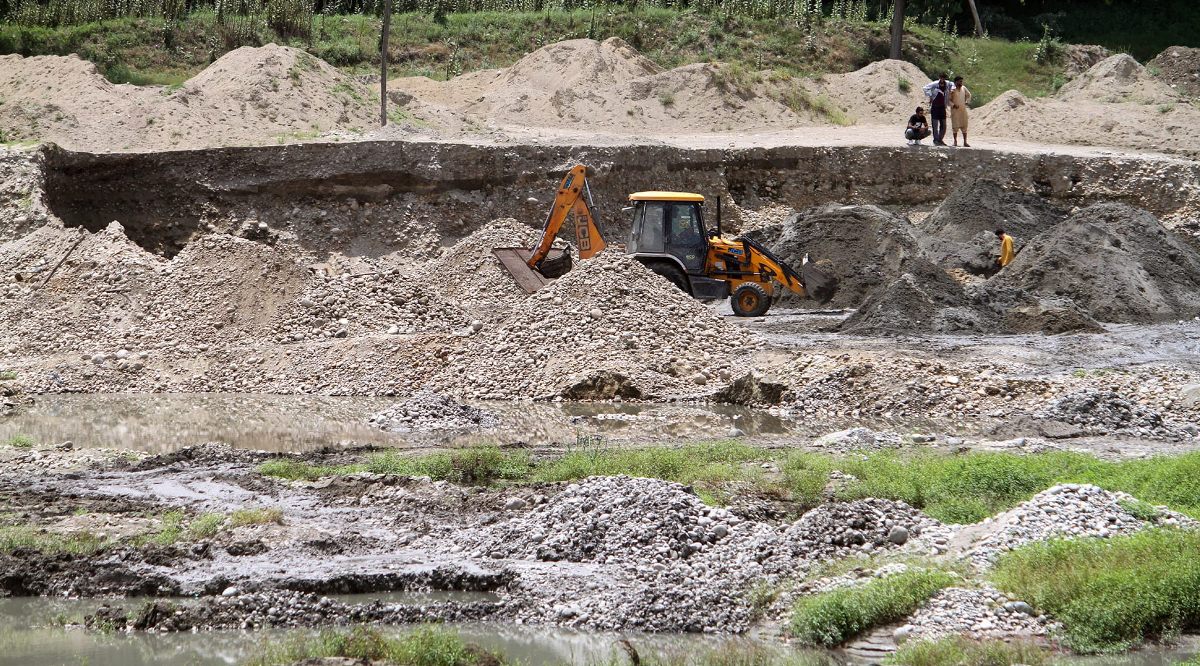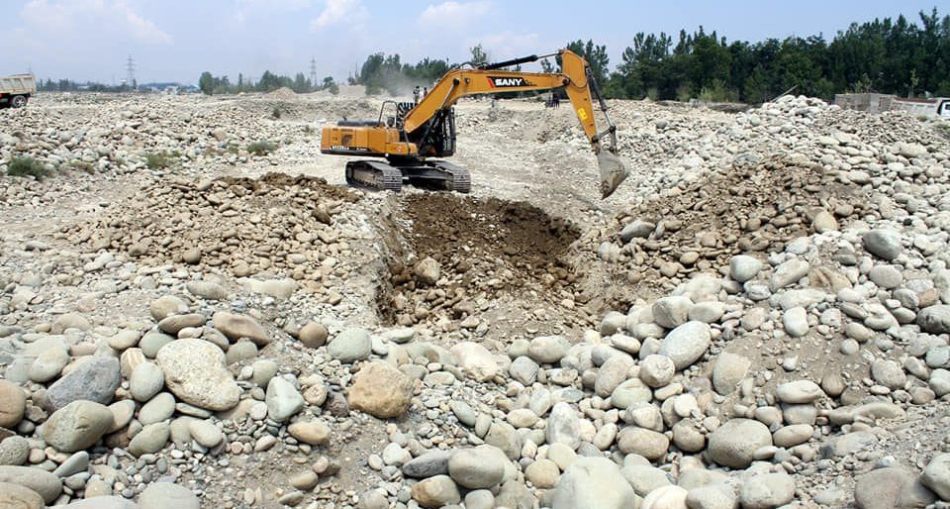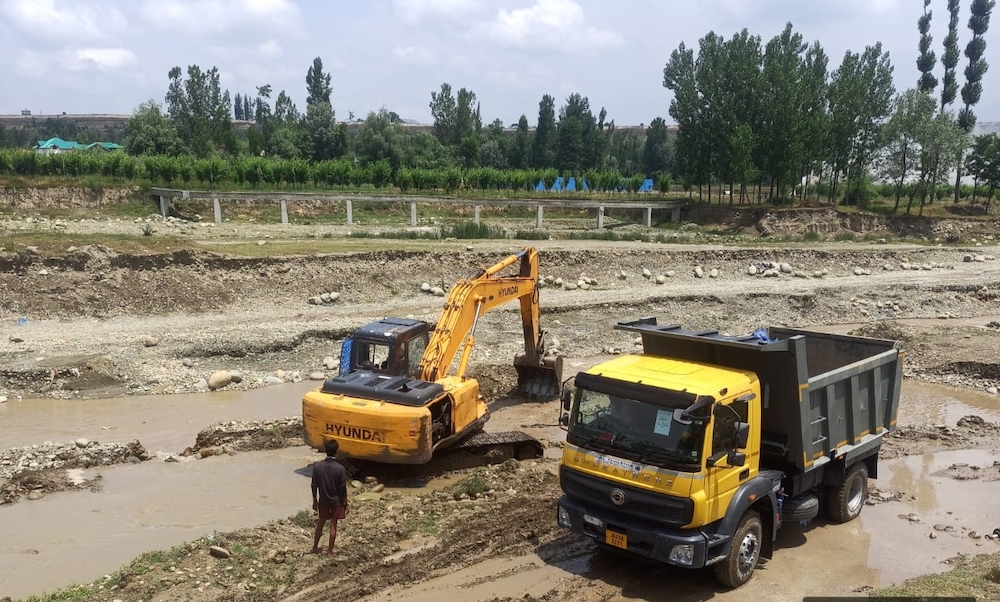The unchecked riverbed mining is ruining Kashmir’s rivers, impacting fish and agriculture but the government is yet to intervene to put brakes on it, reports Safwat Zargar

For the last two years, Mohammad Altaf Bohru, 35, of Kulgam district has been working as a scrap dealer. A father of three, Bohru belongs to Kashmir’s 66,000-strong gaadiheinz, the fishermen community. He lives in Kulgam’s Bhan village which sits on the banks of a Jhelum river tributary, the Vaishav. Like his ancestors, Bohru knew only one occupation all his life – catching fish and then selling them in the market.
Not anymore.
Two years ago, Bohru stopped casting his net. “There are no fish in the river now,” said Bohru on a sultry July afternoon while unloading collected scrap material at a warehouse in Kulgam. He blamed it on the excessive sand mining in Vaishav.
Around five years ago, Bohru said, miners shifted from mining sand manually with shovels to using heavy machinery like excavators, bulldozers and earthmovers, even though their use is forbidden under the conditions set by the environmental clearances. Since then, the catch has speedily declined.
This is not Bohru’s story alone. More than 70 fishermen’s families live in Bhan. Almost everyone has switched to other work. Those who still cast their nets in the river say they are just trying their luck. All of them, in unison, blame rampant mining for the loss of their traditional livelihood.
Abdul Rehman, 60, has been fishing for the last 40 years. “Earlier, if I covered an area of 3 km in the river, I would catch 6-8 kilograms of fish,” he said. “Now, for the same distance, I don’t even get 250 grams of fish.”
Experts say mechanised riverbed mining damages aquatic life by extracting sand and gravel at the bottom of the river, which are key to the nourishment and breeding of fish. “From the scientific point of view, riverbed mining should be banned,” said Dr Farooz Ahmad Bhat, dean of the faculty of the fisheries department, at Sheri Kashmir University of Agricultural Sciences and Technology (SKUAST-K). “Our research concludes that mining is not feasible for the natural ecosystem of the fish.”
But it is not just fish that have been affected by the riverbed mining.
Impact on Agriculture
According to villagers, the extensive riverbed mining has changed the topography of the river, affecting water sources, and drying up farmland, sometimes even leading to the death of mining workers. “Earlier, we knew the river like the back of our hand. Now, the mining has left so many deep pits in the river that we are afraid to go fishing,” Bohru added.
Bhan residents recount three deaths in the last few years which occurred during riverbed mining. “Some of the pits are 20 feet deep, how can anyone come out of it if he falls in it?” Bohru asked.
No Action
Over the last few years, rampant illegal riverbed mining by unlicensed contractors and violations of environmental guidelines by licensed players have been reported across Jammu and Kashmir, prompting concerns from the public about the environmental impact on the region’s fragile ecology and livelihoods.

Even the government’s own figures on illegal mineral mining are staggering. In 2021-22, the authorities seized more than 7,000 vehicles for their involvement in the illegal extraction and transporting of riverbed minerals, such as building stones, gravel, clay, and sand, according to the annual report on sand and river bed mining by the department of geology and mining.
The authorities also seized 35 machines like earth movers and extractors. The total amount of penalties imposed on the illegal miners in the year amounted to more than Rs 14 crore.
In October 2022, the National Green Tribunal imposed a penalty of Rs 35 crore on the Jammu and Kashmir government for failing to prevent pollution and illegal mining in Doodh Ganga, a Jhelum tributary, and the Mamath Kull, a stream which falls in Kashmir’s Srinagar and Budgam district.
“It is seen that there are serious lapses on the part of the administration in waste management and in failing to control illegal mining, which has resulted in huge damage to the environment and public health. Remedial action is inadequate on the ground,” the bench headed by tribunal’s chairperson Justice Adarsh Kumar Goel said in its order.
Scroll travelled to three districts in southern Kashmir – Kulgam, Shopian and Pulwama – to find multiple violations at mining sites, from extraction beyond limits set by the government to the use of heavy machinery like excavators, leading to unchecked environmental devastation. More crucially, the mechanism put in place to monitor and check such violations was completely absent.
‘Lost our sleep’
For most part of his life, Ghulam Mohammad Dar, 75, has cultivated more rice than what he required. From the last five years, his produce is not even sufficient to feed his own family.
“Let’s say I was cultivating 100 bags of rice every season out of which I would sell around 90 bags,” Dar, a resident of Pulwama’s Achan village, said. “Now, I am buying 10 bags from the market for myself. That’s the situation.”
A vast chunk of Dar’s once agricultural land sits on the banks of the Rambiara River which cuts through south Kashmir’s Pulwama and Shopian districts.

Around 2019, Dar said, more and more miners started extracting minerals from the river through the day, abandoning the slow, manual method of mining. They used heavy machinery like excavators, he added, even if this was expressly prohibited by environmental guidelines.
Without any monitoring by government officials, unchecked mining carried on, he alleged. “The large-scale mining brought down the level of the river to more than 15 feet.”
The Law
Accordion to the Jammu and Kashmir Minor Mineral Concession, Storage, Transportation of Minerals and Prevention of Illegal Mining Rules 2016, which regulate riverbed mining in the Union territory, “no mining activity/operation shall be carried out in any river bed below the depth of 3 m [9 feet] or below the water level, whichever is lesser”. However, most of the environmental clearances issued in Jammu and Kashmir restrict the riverbed mining to the depth of only one metre.
“Since our land sat at a height, the water stopped reaching our fields. Hand pumps went dry. Water just disappeared,” Dar added.
In his childhood, Dar said, there were 50 springs in the village fed by the natural underground water channels from the river. “These days, we have only one spring which has water and it has been divided into two villages so that both can use it,” he said.
These days, Dar’s and many other paddy farmers’ land have turned into a patch of weed. “Nothing grows there, it’s a desert now,” he pointed out, stating that the affected land runs in hundreds of kanals.
Such excessive mining has been reported from several rivers in Jammu and Kashmir – Sindh river in Ganderbal, Mawar Nallah in Kupwara, Frastahar Nallah in Baramulla and Arin Wallah of Bandipora.
Impact
Experts are not surprised by such fallout of mining. “As it flows, a river replenishes a larger catchment area through underground water channel networks,” said an academic in agricultural sciences, who did not wish to be identified. “Mining creates deep pits in a riverbed and sometimes causes it to sink downwards, affecting the flow of the river.”
As a result, the expert explained, the river’s connections with the underground water table are also disrupted. “The first impact is always on the vegetation growing on or near the river banks as the river is a source of its nourishment.”
Besides drying up their farms, riverbed mining has also unsettled the villagers in other ways.

Pic: Raja Muzaffar Bhat
Under the environmental guidelines mandatory for mining lease holders, no mined material can be transported through the villages and areas where there is human habitation. The leaseholder, the rules say, has to construct a separate road – at least 200 metres away from the human habitations in the area – to transport the material. Additionally, mining is allowed only between 6 am and 6 pm.
However, villagers from Pulwama, Ganderbal, Shopian and Kulgam districts say most of the mining with heavy machinery takes place during the night. “We have lost our sleep. These huge trucks carrying sand and gravel ply so fast in the night through village roads that our houses shake by their movement,” said Rafiq Ahmad, another local from Achan.
Such reckless driving often leads to accidents. In Kulgam’s Ashmuji village, a truck carrying riverbed material rammed into the gate of a government school last month, causing damage to the school’s main gate.
“Fortunately, no student was at the gate. Had it been during the school opening time or during the off time, it would have been a disaster,” said a teacher from the school, wishing not to be identified. School authorities said the problem went beyond accidents. “It’s illegal to transport material from an area where there is a school. These vehicles cause so much dust and air pollution that we are fed up now,” the teacher added.
According to several villagers in Pulwama and Kulgam, they have repeatedly tried to bring these issues to the notice of various government departments. “From the local police to all the way up to the Kashmir divisional commissioner, we knocked on every door. They heard us but nothing changed on the ground,” a villager, who did not want to be identified, said.
While reporting, Scroll saw heavy machinery like excavators and earthmovers parked near the mining sites during the day. Huge dump trucks transporting riverbed material through the interior roads of the villages were also a common sight.
Monitoring framework
All Flout Norms
While illegal miners – who do not have extraction rights – often fall in the net of law enforcement authorities, a Scroll investigation found that even the legal leaseholders in Jammu and Kashmir are not complying with the conditions of the environmental clearances granted to them.
Since riverbed mining entails an impact on the environment, river ecology and aquatic life, environmental clearances prescribed under the Ministry of Environment, Forest and Climate Change’s 2006 Environment Impact Assessment Notification are mandatory for mining activities.
Until 2016, small-scale mining projects (in areas less than or equal to five hectares) of minor minerals did not require prior environmental clearance from the government. This changed in January 2016, when the Ministry of Environment, Forest and Climate Change laid down a mechanism for small-scale mining projects to get clearance from the government. Under the amended notification, the projects are assessed by a district-level or state-level environment impact assessment authority and a district or state-level expert appraisal committee before a clearance is given.
An environmental clearance certificate has two sets of guidelines for every project. While the standard conditions talk about statutory provisions of ensuring the prevention of air, water or noise pollution and other environmental safeguards, specific conditions are tailored as per the facts and location of a particular mining project.
For example, a miner is allowed to extract minerals from only 60 per cent of the mining area and not more – one such standard condition. Local residents and activists in Kashmir say that the miners not only flout that rule, they even extract minerals from beyond the designated area, including river embankments.
Nocturnal Operations
“Since most of the illegal mining happens at night, there is hardly any check on where they extract,” said Ghulam Mohammad Dar from Pulwama’s Achan village. “It’s only in the day that people realise that these miners have extracted material even from river embankments and the spots of their choice. There is no clear boundary which delineates a mining area from the rest of the river.”
Every project holder also has to generate data on the air quality parameters at mining sites and display them prominently at the site as well as listed in half-yearly compliance reports. In the three districts Scroll travelled to for this story, nowhere was such information put up.
Missing Compliance Reports
One of the conditions in an environmental clearance is the mandatory submission of half-yearly environmental compliance reports before the concerned regulatory authority by the leaseholders. The idea is to ensure that the project is being executed as per the stipulated terms and conditions laid down in the environmental clearance. For Jammu and Kashmir, the central government-appointed Jammu and Kashmir State Environment Impact Assessment Authority is the relevant authority. All the compliance reports submitted by the project holders must also be public documents.
“Copies of the same shall be given to any person on application to the concerned regulatory authority. The latest such compliance report shall also be displayed on the website of the concerned regulatory authority,” the amended 2006 Environment Impact Assessment Notification says.
But no such compliance report has been uploaded on the Union ministry’s Parivesh portal by project owners, who have been granted environmental clearance in Jammu and Kashmir.
According to Parivesh portal, 244 projects have been granted environmental clearance in Jammu and Kashmir since July 2015. However, details and documents of only 146 projects are available on the portal. Most of these projects are related to lucrative riverbed mineral mining. Not a single one of them has submitted environmental compliance reports since 2015.
The website of the Jammu and Kashmir Pollution Control Committee, the nodal authority for dealing with cases related to pollution or environment management, also does not host any of the compliance reports.
According to the enforcement and monitoring guidelines for sand mining, 2020, issued by the Ministry of Environment, Forest and Climate Change, the “State Pollution Control Board shall initiate appropriate action under the provision of these acts for non-compliance or violation of the provisions.”
Scroll asked the Jammu and Kashmir Pollution Control Committee whether it has found any violation regarding the environmental violations due to mining. It did not reply.
Scroll requested meetings with the member secretary of the Jammu and Kashmir State Environmental Impact Assessment Authority, and the member secretary of the Jammu and Kashmir Pollution Control Committee. They did not respond to repeated calls and messages.
The director of Jammu and Kashmir’s geology and mining department also did not respond to calls and messages from Scroll.
The director of the Jammu and Kashmir government’s fisheries department did not take calls or reply to messages from Scroll on the impact of mining on aquatic life.
On August 2, Scroll mailed detailed questionnaires to the Jammu and Kashmir State Environmental Impact Assessment Authority and Jammu and Kashmir Pollution Control Committee about the findings of this story. The story will be updated if they respond.
(The report first apperaed on the Scroll website and was republshed with permession.)
from Kashmir Life https://ift.tt/L5udDTx
via IFTTThttps://kashmirlife.net
No comments:
Post a Comment